Effects of urea molasses straw on growth performance and hemato-biochemical parameters in Sahiwal steers
Abstract
At relatively low concentrations in the diet, molasses is extensively used as a vital energy supplement to improve growth, meat quality, and general health condition. However, there is little information on feeding molasses to steers: that’s why the study sought to determine the effects of urea molasses supplementation on growth performance and hemato-biochemical parameters. Twenty Sahiwal steers between 1.5 and 2 years old were divided into two groups (n=10); steers of group A received untreated straw (Control), while steers of group B received urea molasses straw (UMS). The body weight of the steers was measured at every 15 days intervals, and after 90 days of the experimental period blood samples were collected and serum was prepared for hemato-biochemical analysis. The result revealed that body weight of the UMS-treated steers increased significantly from day 15 to day 90 of the experiment compared to the untreated control. UMS induced a significant increase in hematological parameters such as TEC (p<0.01), Hb (p<0.01), and PCV (p<0.05), whereas there were no alterations in TLC and DLC values. Further, UMS treated group showed no significant changes in biochemical parameters such as AST, ALT, and lipid profile (TC, TG, HDL, LDL) while urea and creatinine levels increased significantly (p<0.05). Therefore, it could be suggested that UMS had beneficial effects on growth performance and hemato-biochemical parameters in Sahiwal steers.
INTRODUCTION
The term agriculture is the integration of crops, livestock, fisheries, and forestry [1]. Livestock, one of the four aspects of agriculture, is essential to the national economy [2], accounting for roughly 6.5% of GDP and 13% of total foreign exchange revenues [3]. Bangladesh has a population of 118.7 million poultry, 34.1 million ducks, 14.8 million goats, 1.9 million sheep, 0.83 million buffaloes, and 25.7 million cattle [4]. Since, 25% of Bangladesh’s population works directly in the livestock industry, and 50% of the population has a partial association with livestock production [5], livestock may be considered a form of “cash income” for rural farmers who are always willing to sell or trade [5]. For small farmers in Bangladesh, raising cattle for beef production has grown to be a significant business [2]. Additionally, cattle fattening can significantly contribute to rural people’s ability to meet their needs for animal protein and to reduce their level of poverty [6]. Whereas, it is believed that stimulants like steroids and feed additives may be utilized in Bangladesh for fattening purposes [7]. On the other hand, experts believe that acute shortages of feeds and fodder have significantly hampered efforts to increase cattle output there. Additionally, during Eid-ul-Adha in Bangladesh, a festive demand for beef cattle increases the importance of the productive performance of cattle [8]. Therefore, to make the current beef production system more viable for farmers, it is imperative to identify its constraints.
In tropical and subtropical nations, straw is a significant agricultural residue that makes up the majority of the fiber in ruminants’ diets [3]. In Bangladesh, rice straw makes up around 23.57 million tons (81%) of the 29.1 million tons of roughage that are accessible for ruminants, whereas green grasses make up only 1.6 million tons [9]. As a result, rice straw, which has low nutritional value and low digestibility, serves as the basal feed for ruminants [10]. The effective use of this rice straw, which has a low nitrogen concentration and digestibility due to its high content of lignin, silica, and oxalate, is crucial for animal productivity in Bangladesh [11]. That is why our animals’ performance is subpar [12].
It was found that feeding animals straw along with a urea and molasses mixture increases feed intake and straw digestibility [9]. A non-protein nitrogenous substance called urea can be added to the rations of ruminants to serve as a protein supplement which is converted to protein by rumen microorganisms [13]. One of the most commercially significant by-products of sugar mills is molasses, which is simple to produce and provides energy, minerals, and vitamins relatively quickly [14]. It enhances the sweetness of the flavor and odor of the feed while also adding to its effectiveness [15]. Moreover, numerous research revealed that urea molasses straw (UMS) can increase feed intake and body weight in animals [15]. Through improved microbial protein, digestibility, and feed intake for a better balance of amino acids and energy absorption during nutrient intake, UMS supplements may have an impact on body weight [16]. It is also proven that UMS has positive effects on the hematological parameters of animals such as the number of red blood cells, white blood cells, hematocrit value, hemoglobin concentration, percentage of neutrophils, lymphocytes etc [17]. Moreover, serum biochemical parameters of animals can be altered by supplementation of UMS with traditional feed materials [18]. An affordable method of giving ruminants the right amount of protein and energy is to combine non-protein nitrogenous components with molasses [19]. Whereas, in Bangladesh, there is limited information available about the supplementation of UMS for steers and its effect on body weight and hemato-biochemical parameters. Hence, the current study aimed to determine the effects of UMS on body weight changes, hematological parameters, and biochemical parameters in Sahiwal steers.
MATERIALS AND METHODS
Experimental animal and design
Twenty Sahiwal steers (Boss indicus), weighing 100 to 120 kg and aged 1.5 to 2 years were selected randomly from a farm located in Dakshindihi, Phultala, Khulna, Bangladesh. The steers were randomly assigned to two groups (n=10), the steers of group A were treated with normal straw along with concentrate (Control) and the steers of group B were treated with UMS along with regular concentrate.
All the procedures and protocols applied in the current study were authorized by the Animal Welfare and Experimentation Ethics Committee of Bangladesh Agricultural University and the ethical approval number was AWEEC/BAU/2022(70).
Managemental practice of the animals
Steers were kept in an intensive housing system. Normal rice straw was used as feeding material along with grasses and concentrated feeds. Routine deworming of the selected steers was done using broad spectrum anthelmintic, Renadex® (Renata Company) @1 bolus/80kg body weight of animal (Levamisole 600 mg + Triclabendazole 900 mg) 14 days prior to the starting of UMS feeding; the steers of the control group were also treated as same.
Preparation of urea molasses straw
The composition of urea molasses straw (UMS) which innovated in Bangladesh Livestock Research Institute, Savar, Dhaka is shown in Table 1. The ingredients for preparing UMS were purchased from the local market of Khulna town. UMS was prepared by the cold method [20]. Firstly, the molasses was taken in a bowl and mixed with urea and water. The molasses mixture was then transferred to the small pieces of straw and mixed to give a thick paste with a sticky consistency. The mixture was then carried to an air-tight dish and then placed in a dark room for 2-3 hours to make it more compact. After preparation of the UMS, they were cut to 2 kg for the experimental group and were supplied to the steers of the experimental group.
Table 1. Composition of urea molasses straw.
Storage and feeding of UMS
To protect from fungus and soil dust particles, the UMS were covered with polyethylene after preparation and was stored in a dark storeroom at atmospheric temperature for future use. The UMS was supplied 2 kg per animal in group B. Total UMS was divided into two equal half and was placed in a small bowl for feeding in the morning and the evening. All the steers in each group had free access to regular grazing and clean drinking water.
Body weight measurement
Throughout the 90-days experimental period, the steers’ body weight was assessed using a balance and weight box at intervals of 15 days (90 days). Before the animal was fed in the morning, the animal’s body weight was recorded and represented in kilograms (kg).
Blood collection and serum preparation
Blood samples from the jugular vein of both groups of animals were taken aseptically for the hemato-biochemical analysis using a sterile syringe and needle. From each animal, about 5ml of blood was collected and immediately shifted to a falcon tube containing anticoagulant 4% sodium citrate solution (Research-Lab Fine Chem Industries, Mumbai, India) at a ratio of 1:10 for the hematological tests. About another 5 ml of blood collected from each animal was immediately shifted to another falcon tube which was used to separate serum by centrifugation (1500 rpm for 30 minutes) for biochemical tests [21]. The collected samples were brought to Bangladesh Agricultural University, Mymensingh-2202 for hemato-biochemical studies.
Hematological examinations
Blood samples collected from the experimental steers were analyzed for the determination of total erythrocyte count (TEC), hemoglobin concentration (Hb), packed cell volume (PCV), total leukocyte count (TLC), and differential leukocyte count (DLC) according to the standard method [22].
Bio-chemical analysis
The Reflotron® auto-analyzer (Boehinger Mannheim, Germany) was used to analyze blood samples for the following tests: aspartate aminotransferase (AST), alanine transaminase (ALT), urea and creatinine level, and lipid profile such as total cholesterol (TC), triglycerides (TG), low-density lipoprotein (LDL) level, and high-density lipoprotein (HDL) level at Professor Mohammad Hussain Central Laboratory, Bangladesh Agricultural University, Mymensingh-2202.
Statistical analysis
The obtained data were analyzed using GraphPad Prism (version 9.3.1) following complete randomized design after curation of data in Microsoft Excel-2010. All the data were expressed as mean ± SD. Unpaired t-test was done setting statistical significance at p<0.05 to compare between the two groups of animals.
RESULTS
Effect of UMS feeding on body weight
There were no significant changes of the body weight of the steers between the UMS-treated group and the untreated control group at day 1 of the experiment (Figure 1). But the steers treated with UMS showed a significant change in body weight compared to the untreated steers of the control group from day 15 up to the end of the experiment at day 90 (Figure 1). At day 15 and day 30, the body weight of the steers of UMS treated group increased significantly at 5% level of significance (p<0.05) compared to the untreated steers of the control group (Figure 1). Similarly, at day 45 and day 60, the body weight of the steers of UMS treated group increased significantly at 1% level of significance (p<0.01), and in the case of day 75 and day 90 increased at 0.1% level of significance (p<0.001) compared to the untreated steers of the control group (Figure 1).
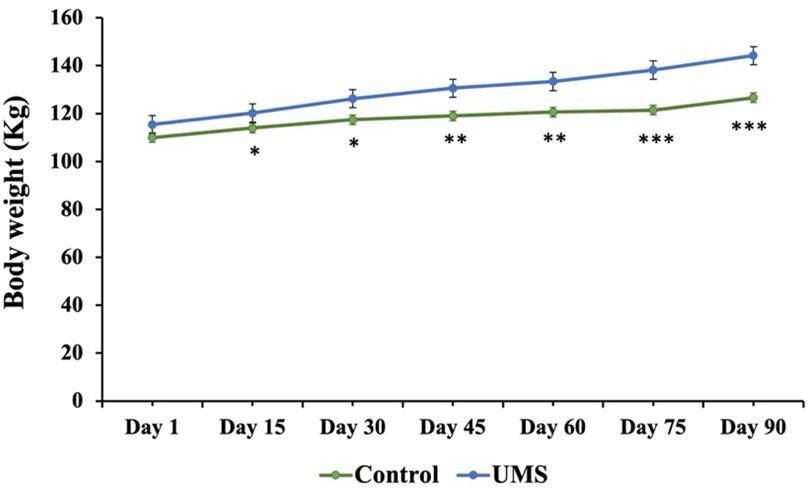
Effect of UMS feeding on hematological parameters
Figures 2 to 4 show the hematological measurements (TEC, Hb, PCV, TLC, and DLC) of the steers from the control and treatment groups at the conclusion of the experiment. The levels of TEC and Hb were significantly (p˂0.01) raised in steers of the treatment group compared to the untreated steers of the control group (Figure 2). Similarly, PCV was also increased significantly (p˂0.05) in the steers of treatment group compared to the untreated steers of the control group (Figure 2). Whereas there were no significant changes in the case of TLC in the steers of treatment group compared to the untreated steers of the control group (Figure 3). In the case of DLC, the percentages of neutrophil, eosinophil, basophil, lymphocyte, and monocyte were not significantly changed between the steers of the treatment and control group (Figure 4).
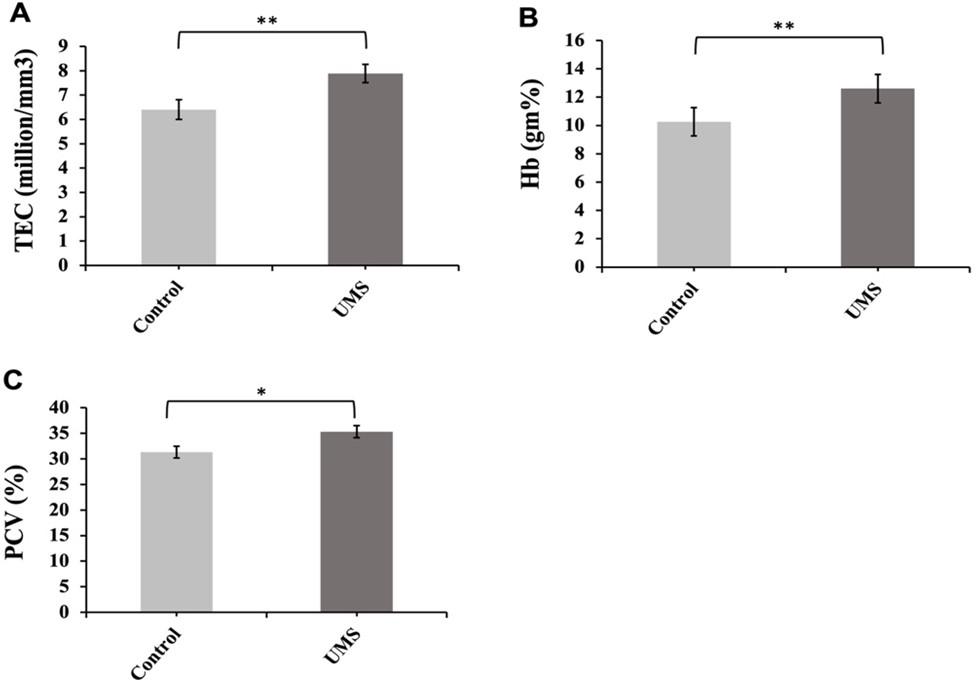
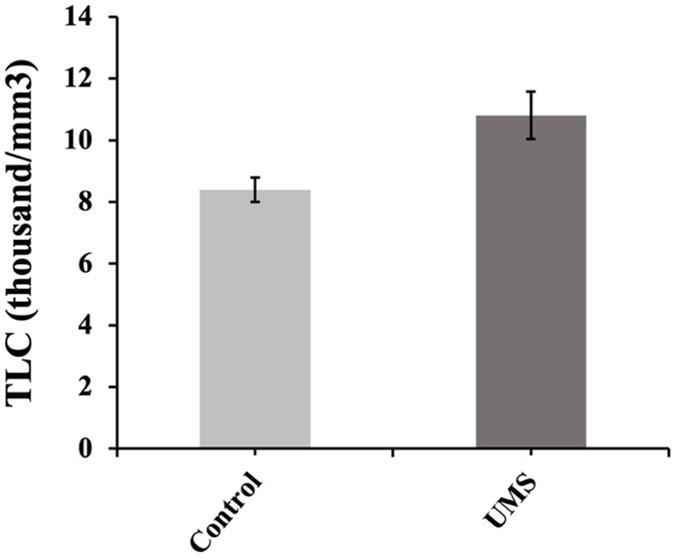
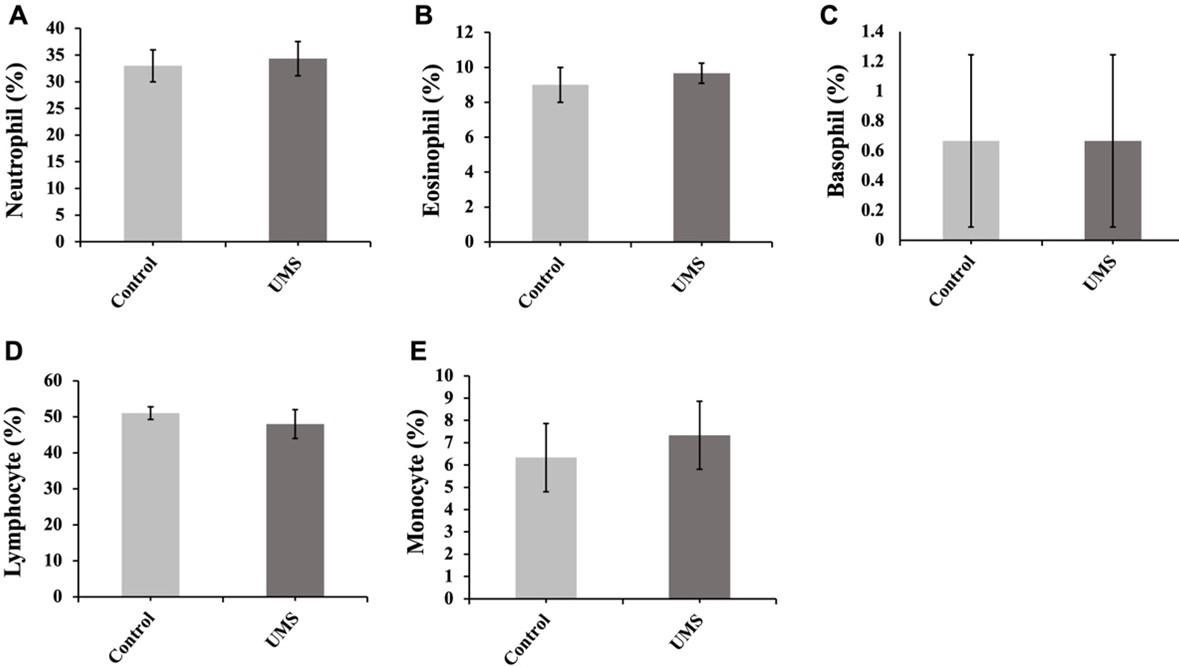
Effect of UMS feeding on liver function
At the end of the experiment, the values of liver enzymes such as AST and ALT were not significantly changed in the UMS-treated group compared to the untreated steers of the control group (Figure 5).
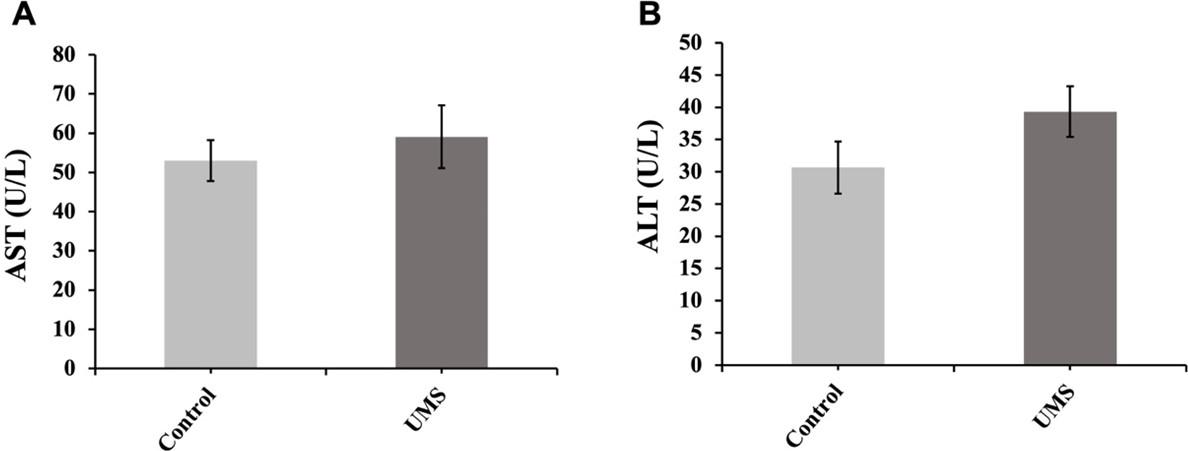
Effect of UMS feeding on kidney function
Both serum urea and creatinine levels of the steers of the treatment group were significantly increased (p<0.05) compared to the untreated steers of the control group at the end of the experimental period (Figure 6).
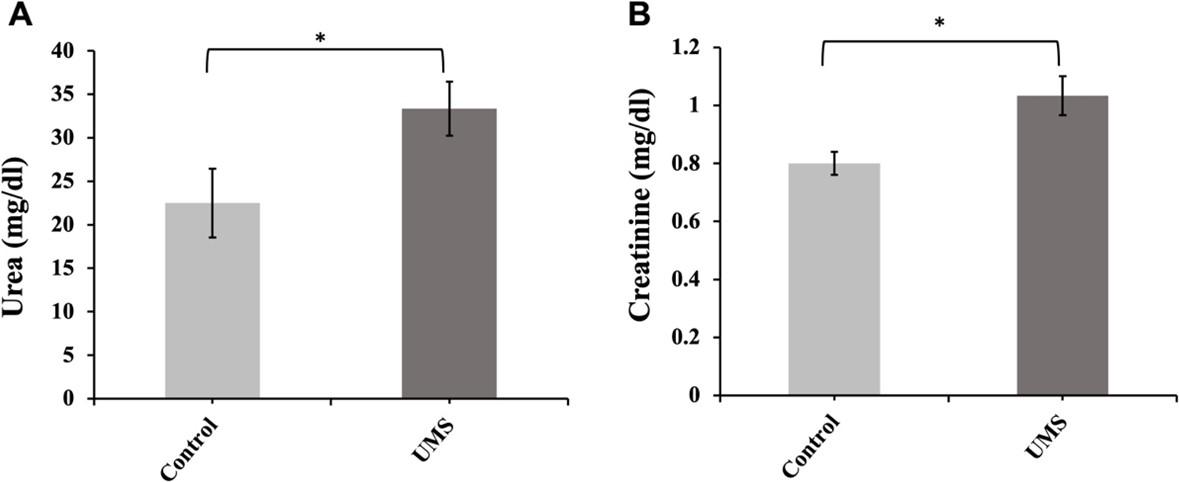
Effect of UMS feeding on lipid profile
The mean values of lipid profiles such as TC level, TG level, LDL level, and HDL level were not significantly changed in the steers of the treatment group compared to the untreated steers of the control group after the end of 90 days experimental period (Figure 7).
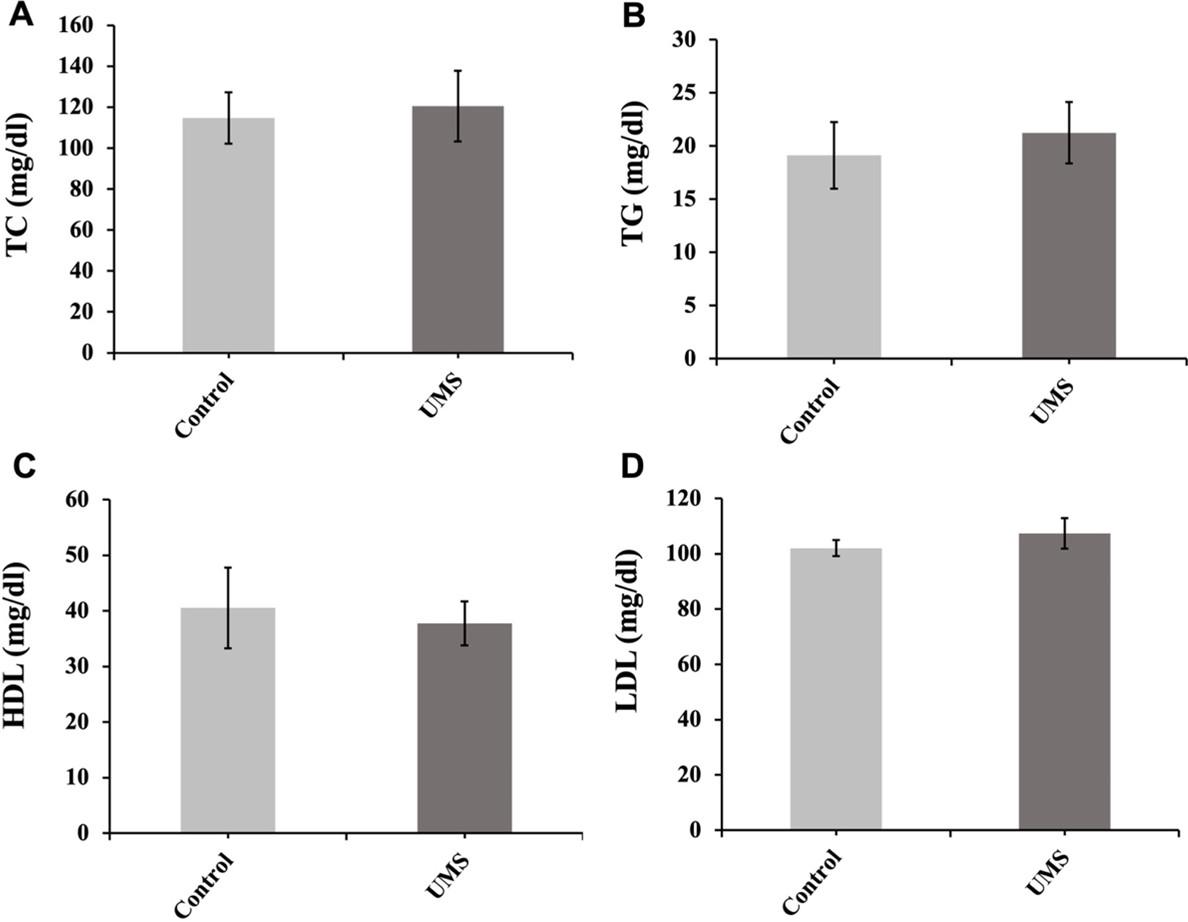
DISCUSSION
The present study revealed that the steers treated with UMS induced a significant increase of body weight of steers compared to the control. The findings can be compared to earlier studies that found feeding UMS along with wheat bran resulted in a greater response in terms of daily live weight gain in cattle [12]. A prior study reported a linear increase of body weight following the treatment of animals with UMS [23]. UMS supplemented group showed an increase in straw intake that may be attributed to the improvement in palatability and the addition of sufficient nitrogen, energy, and minerals. in straw intake might be due to the increase in palatability and due to supplementation of adequate nitrogen, energy, and minerals [15]. This acceleration of rumen fermentation was reflected in the fermentation of a higher amount of straw, which in turn led to a higher amount of straw consumption [15]. Another study also analyzed and reported that UMS supplements may affect body weight by increasing microbial protein, digestibility, and feed intake for a more optimal balance of amino acids and energy absorption during nutrient intake [16]. The result revealed that UMS feeding can improve the body weight of steers.
In contrast to the control, our study found that UMS feeding significantly increased the hematological parameters such as TEC, Hb concentration, and PCV. These findings concur with those of other studies, which found that urea molasses produces a rise in hematological variables such TEC, Hb, and PCV [15]. The increase of the values might be due to a higher intake of nutrients through UMS and improved digestibility of straw by urea treatment [24]. The iron, copper, and zinc components in molasses are important nutrients required for erythropoiesis and these could have possibly elevated the RBC and Hb concentration [17]. Blood Hb is an indicator of the erythrocytic normal level and general well beings of animals [25]. The level of PCV varies due to some factors like age, sex, physiological state, sexual maturity, drinking water etc. [26]. The highest levels of PCV due to urea molasses could also be attributed to improved nutrient availability resulting in enhanced erythropoiesis [17]. In the case of TLC and DLC, there were no significant changes between the steers treatment and control group. The findings are in agreement with a prior study [27]. The count (TLC) and type (DLC) of white blood cells not differing significantly indicates that feeding patterns do not adversely affect the immune cells and animal apparent health [17]. The findings are revealing that molasses supplementation had good impacts on both the hematological system and immunological cells of the body of steers
AST and ALT, key enzymes of liver have vital role on liver function, and they are the markers of liver function and have impact on protein metabolism [28]. The results found in the current investigation demonstrated that blood AST and ALT values were not altered significantly in response to dietary molasses intake. The findings are similar with a prior research [27] and all of these indicate that that the steers were conserved under normal health condition without any hazardous effects of molasses supplementation on hepatocellular metabolism and liver function as supported by the improved growth performance [15]. The result revealed that UMS feeding had no adverse effect on liver function of steers.
A comparatively higher level of urea in UMS supplemented group in present investigation agrees with a prior research which reported that the urea level was higher in animals offered UMS supplemented diets as compared to the conventional control group [29]. The comparative increase of creatinine levels in the present study is in agreement with earlier studies [30]. Measuring blood creatinine and urea is a useful and inexpensive approach of detecting renal dysfunction and the increasing amount of them is an important sign that represents renal function [31]. Although, urea and creatinine level were slightly higher in treatment group, but no symptoms of toxicity were noticed during the entire experimental period and all animals were reported to be active and in good condition. This can be because to reduced dose or shorten duration of urea molasses in the feed.
In the current study, exposure to urea molasses caused no significant changes in the TC, TG, HDL, and LDL values. The findings regarding the effect of urea molasses on serum lipid is consistent with those obtained by previous studies who reported that supplementation of urea molasses do not have an ill effect on the health status resulted from no influence on lipid parameters [32]. Some other studies on lipid profile also found that there was no significant variation between UMS treatment and control group of animals in the concentrations of cholesterol, triglyceride, HDL, and LDL in plasma [30, 33]. The result revealed that UMS feeding had no adverse effect on the lipid profile of steers.
CONCLUSION
We can conclude that except slight increase of urea and creatinine, urea is useful in improving straw consumption, and general health (body weight and hemato-biochemical properties) of the steers if supplemented with proper rate and ratio. To minimize the adverse effects and get a comprehensive result the duration of the experiment should be prolonged. Further study should be carried out including more parameters to determine any toxicity of UMS.
ACKNOWLEDGEMENTS
The laboratory staff and demonstrators at the Department of Physiology, Bangladesh Agricultural University, Mymensingh-2202, Bangladesh are gratefully acknowledged by the authors. The authors would also like to acknowledge Professor Mohammad Hossain Central Laboratory, Bangladesh Agricultural University, Mymensingh-2202, Bangladesh for laboratory support.
AUTHORS CONTRIBUTIONS
SI performed the research work, analyzed the data, and wrote the draft of the manuscript; MEJB helped in writing the manuscript and analyzing the data; MGH critically revised the initial draft and data analysis; MERB helped in research planning and revised the initial draft; and SA designed and performed the research work, finalized the manuscript, and supervised the overall research work.
CONFLICTS OF INTEREST
There is no conflict of interest among the authors.
References
- [1]Deb U. Agricultural Transformation in Bangladesh : Extent , Drivers and Implications. Int. Crop. Res. Inst. Semi-Arid Trop. Patancheru 502324, Telangana, India, 2016.
- [2]Kamal M, Hashem M, Mamun M Al, Hossain M, Razzaque M. Study of cattle fattening system in selected region of Bangladesh. SAARC J Agric 2019;17:105–18.
- [3]Baset MA, Rahman MM, Islam MS, Das GB, Ara A. Beef Cattle Production in Bangladesh – A Review. J Biol Sci 2002;2:429–35.
- [4]Begum F, Islam MM, Sohidullah M, Kabir SML, Islam M, Rahman MT. Molecular Identification and Antibiogram Profiles of Escherichia Coli Isolated From Apparently Healthy and Diarrheic Goats. Bangladesh J Vet Med 2017;14:203–8.
- [5]Hossen M, Hossain M, Abedin M, Karim M, Rume F. Animal Production Strategies in Southern Region of Bangladesh. Agric 2010:77–83.
- [6]Mustafa M, Islam M, Rahman M. Effect of feed on the performance of upgraded Holstein Friesian bulls during fattening at BAPARD cattle farm in Bangladesh. Asian J Med Biol Res 2021;6:761–7.
- [7]Islam M, Hashem M, Hossain M, Islam M, Rana M, Habibullah M. Present Status on the Use of Anabolic Steroids and Feed Additives in Small Scale Cattle Fattening in Bangladesh. Progress Agric 2013;23:1–13.
- [8]Huque K, Sarker N. Feeds and feeding of livestock in Bangladesh: performance, constraints and options forward. Bangladesh J Anim Sci 2014;43:1–10. https://doi.org/10.3329/bjas.v43i1.19378.
- [9]Saha NG, Akter QS, Chowdhury RH, Tareq KMA. Effect of urea molasses straw on beef fattening at Haor areas 2018;5:9–15.
- [10]Sarnklong C, Coneja JW, Pellikaan W, Hendriks WH. Utilization of rice straw and different treatments to improve its feed value for ruminants: A review. Asian-Australasian J Anim Sci 2010;23:680–92.
- [11]Islam O, Akter S, Islam MA, Jamee DK, Khan RI. Preparation of wastelage with poultry droppings and rice straw (Oryza sativa L.) as a cattle feed. Asian J Med Biol Res 2018;4:251–8.
- [12]Baset MA, Rahman MM, Ali ML, Mahbub ASM, Haque MN. Effect of Urea Molasses Straw (UMS) on the Performance of Steers (Local Zebu Cattle) with Supplementation of Wheat Bran. Pakistan J Biol Sci 2002;5:807–8.
- [13]Panday D. Urea As a Non-Protein Nitrogen Sources for Ruminants. Alltech Young Sci Compet 2010:1–14.
- [14]Dotaniya ML, Datta SC, Biswas DR, Dotaniya CK, Meena BL, Rajendiran S, et al. Use of sugarcane industrial by-products for improving sugarcane productivity and soil health. Int J Recycl Org Waste Agric 2016;5:185–94.
- [15]Kerketta N, Victor VM, Chandraker AK, Jogdand S V. Effect of Urea Molasses Mineral Block as Feed Supplement on Body Weight Gain and Haemato- biochemical Parameters of Working Bullocks. Int J Agric Innov Res 2017;5:917–20.
- [16]Yanuartono Y, Nururrozi A, Indarjulianto S, Purnamaningsih H, Haribowo N, Oktawan AD. Effect supplementation of Urea Molasse Multinutrient Block (UMMB) on the weight gain average of Heifers Peranakan Ongole breed. Digit Press Life Sci 2018;1:00006.
- [17]Ezihe CO, Dagih AA. Effect of molasses on performance, haematology and serum chemistry of broiler chickens. Sokoto J Vet Sci 2019;17:60.
- [18]Muralidharan J, Jayachandran S, Thiruvenkadan AK, Singh DAP, Sivakumar K. Effect of concentrate and urea molasses mineral block supplementation on the blood biochemistry of off season Mecheri lambs. Indian J Anim Res 2015;49:409–12.
- [19]Tadele Y, Ameha N. Use of different non protein nitrogen sources in ruminant nutrition: A review 1. Sch J Agric Sci 2015;5:84–9.
- [20]Sansoucy R. The contribution of livestock to food security and sustainable development (Keynote paper). Proc Jt FAO/ILRI Roundtable Livest Dev Strateg Low Income Countries, ILRI, Addis Ababa, Ethiop 27 February-02 March 1995 1995:182.
- [21]Akter MT, Bhuiyan MEJ, Sujan KM, Haque Z, Akter S. Investigation of growth performance , lipid profile , and liver histotexure of mice treated with butyric acid 2021.
- [22]Ghai C. A Textbook of Practical Physiology. 8th editio. Jaypee Brothers Medical Publishers (p) Ltd, New Delhi.; 2012.
- [23]Alam MGS, Ul-Azam MS, Khan MJ. Supplementation with urea and molasses and body weight, milk yield and onset of ovarian cyclicity in cows. J Reprod Dev 2006;52:529–35.
- [24]Kerketta N, Victor V, Praveen K, Chandraker A. Effect of Urea Treated Rice Straw along with Urea Molasses Mineral Block Supplementation on Body Weight Gain, Feed Intake and Haemato-biochemical Parameters of Working Bullocks. Int J Livest Res 2019;9:1.
- [25]Sankar V. Influence of urea molasses mineral blocks having bentonite as binder on haemato-biochemical and serum mineral profile of crossbred calves. J Anim Res 2020;10.
- [26]Qais M. Studying some physiological and immunological parameters in pregnant women with thyroid gland problems, a thesis submitted to the council of the college of biology 2018.
- [27]Osman OA, Elkhair NM, Abdoun KA. Effects of dietary supplementation with different concentration of molasses on growth performance, blood metabolites and rumen fermentation indices of Nubian goats. BMC Vet Res 2020;16:1–12.
- [28]Ma J, Ma C, Fan X, Shah AM, Mao J. Use of condensed molasses fermentation solubles as an alternative source of concentrates in dairy cows. Anim Biosci 2021;34:205–12.
- [29]Choubey M, Wadhwa M, Bakshi MPS. Evaluation of urea molasses multi-nutrient blocks containing alternate feed resources in buffaloes. Buffalo Bull 2015;34:5–16.
- [30]Kioumarsi H, Yahaya ZS, Rahman AW. The Effect of Molasses/Mineral Feed Blocks Along with the use of Medicated Blocks on Haematological and Biochemical Blood Parameters in Boer Goats. Asian J Anim Vet Adv 2011;6:1264–70.
- [31]Reza T, Aktar S, Amin H Al, Rahman M, Arefin A, Mohanto NC, et al. In vivo analysis of toxic effect of hydrose used in food preparations in Bangladesh. Asian Pac J Trop Biomed 2014;4:884–9.
- [32]Kurechiya N, Mehta M, Jain R, Rawat K, Mahour S. Effect of Non- Urea and Urea-Based Concentrate Supplements on Haematology and Blood Biochemical Parameters in Kids. Int J Livest Res 2021;11:1.
- [33]Cenesiz S, Atakisi O, Ozcan A, Yuceyurt R, Unal Y. Effect of Feed Supplemented with rea Molasses Mineral Blocks on Activity of Serum AST, ALT and Levels of Total Protein, Glucose, Triglyceride, Total Lipid, Total Cholesterol in Lambs. Kafkas Univ Vet Fak Derg 2006;12(2):40.